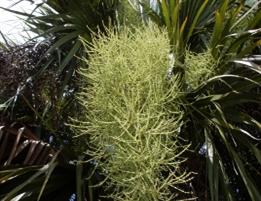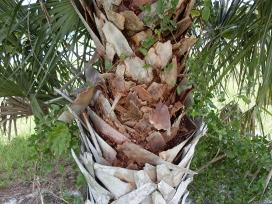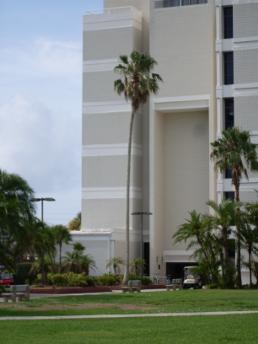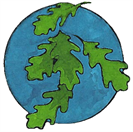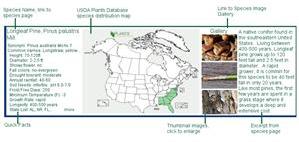
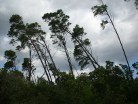
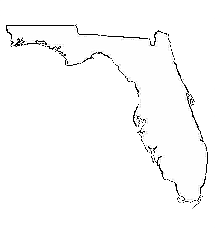

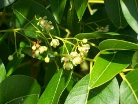
Florida
Home>Browse by State>Florida
The Sunshine State, 'In God We Trust'
Florida is a nature lover's paradise. It is home to a wide variety of trees, many not found elsewhere in North America. Its diversity is supported by the numerous types of habitats such as swamps, bottomlands, sandy hills and dunes, rivers, estuaries, brackish waterways, prairies, and grasslands. Florida is also home to amazing wildlife like manatees, dolphins, the endangered Florida panther, the tiny endangered Key deer, and birds galore.

-Color denotes a tree that is rare or endangered

Want to add your tree to our picture gallery? Click here for details!


™

- Trees
- A-Z scientific
- A-Z by Common Name
- Families
- Aceraceae Maple Family
- Anacardiaceae Sumac Family
- Annonaceae Custard Apple Family
- Aquifoliaceae Holly Family
- Arecaceae, Palm Family
- Betulaceae Birch family
- Bignoniaceae Trumpet Creeper Family
- Burseraceae Frankincense Family
- Caprifoliaceae Honeysuckle Family
- Chrysobalanaceae Coco-plum Family
- Cornaceae Dogwood Family
- Cupressaceae Cypress Family
- Cyrillaceae Cyrilla Family
- Ebenaceae Ebony Family
- Ericaceae Heath Family
- Fabaceae Pea Family
- Fagaceae Beech Family
- Hamamelidaceae Witch Hazel Ffamily
- Hippocastanaceae Horse Chestnut Family
- Juglandaceae Walnut Family
- Lauraceae Laurel Family
- Leitneriaceae Corkwood Family
- Magnoliaceae Magnolia Family
- Meliaceae Mahogany Family
- Moraceae Mulberry Family
- Myricaceae Bayberry Family
- Myrsinaceae Myrsine Family
- Myrtaceae Myrtle Family
- Nyctaginaceae Four Oclock Family
- Olacaceae Olax Family
- Oleaceae Olive Family
- Pinaceae Pine Family
- Platanaceae Plane Tree Family
- Polygonaceae Buckwheat Family
- Rhamnaceae Buckthorn Family
- Rosaceae Rose Family
- Rubiaceae Madder Family
- Rutaceae Rue Family
- Salicaceae Willow Family
- Sapindaceae Soapberry Family
- Sapotaceae Sapodilla Family
- Simaroubaceae Quassia Family
- Styracaceae Storax Family
- Symplocaceae Sweetleaf Family
- Theaceae Tea Family
- Tiliaceae Lindon Family
- Ulmaceae Elm Family
- Taxaceae Yew Family
- Yucca Family
- Browse by State
- Rare or Endangered Species
- Trees_with_Special_Uses
- Tallest and Biggest
- Noxious Weeds
- Causes
- About Us
- Our Stores

- Trees
- A-Z scientific
- A-Z by Common Name
- Families
- Aceraceae Maple Family
- Anacardiaceae Sumac Family
- Annonaceae Custard Apple Family
- Aquifoliaceae Holly Family
- Arecaceae, Palm Family
- Betulaceae Birch family
- Bignoniaceae Trumpet Creeper Family
- Burseraceae Frankincense Family
- Caprifoliaceae Honeysuckle Family
- Chrysobalanaceae Coco-plum Family
- Cornaceae Dogwood Family
- Cupressaceae Cypress Family
- Cyrillaceae Cyrilla Family
- Ebenaceae Ebony Family
- Ericaceae Heath Family
- Fabaceae Pea Family
- Fagaceae Beech Family
- Hamamelidaceae Witch Hazel Ffamily
- Hippocastanaceae Horse Chestnut Family
- Juglandaceae Walnut Family
- Lauraceae Laurel Family
- Leitneriaceae Corkwood Family
- Magnoliaceae Magnolia Family
- Meliaceae Mahogany Family
- Moraceae Mulberry Family
- Myricaceae Bayberry Family
- Myrsinaceae Myrsine Family
- Myrtaceae Myrtle Family
- Nyctaginaceae Four Oclock Family
- Olacaceae Olax Family
- Oleaceae Olive Family
- Pinaceae Pine Family
- Platanaceae Plane Tree Family
- Polygonaceae Buckwheat Family
- Rhamnaceae Buckthorn Family
- Rosaceae Rose Family
- Rubiaceae Madder Family
- Rutaceae Rue Family
- Salicaceae Willow Family
- Sapindaceae Soapberry Family
- Sapotaceae Sapodilla Family
- Simaroubaceae Quassia Family
- Styracaceae Storax Family
- Symplocaceae Sweetleaf Family
- Theaceae Tea Family
- Tiliaceae Lindon Family
- Ulmaceae Elm Family
- Taxaceae Yew Family
- Yucca Family
- Browse by State
- Rare or Endangered Species
- Trees_with_Special_Uses
- Tallest and Biggest
- Noxious Weeds
- Causes
- About Us
- Our Stores
We are part of the Hubpages community.
Click here for more info.
Click here for more info.

Custom Search
Native Trees of Florida

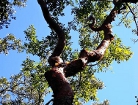
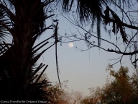
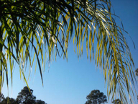

State Tree: Cabbage Palm
The most common palm in
Florida, the cabbage palm is known by many
names. Also called Sabal palm, this native
tree is the scenic staple of Florida, from the
scrub forest to the beaches and was named
the state tree in 1953. Reaching up to 90 feet
in height, cabbage palm is a front yard favorite
and is commonly planted in parks, along
roads, and at tourist destinations. This tree
also has a long ethnobotanical history in the
state. The palm heart, bud foliage, and fruits
were all eaten by native peoples such as the
Seminoles and Choctaw.


Florida Tree Facts
Forested acres: 16 million
Percent of land forested: 47%
Predominant forest types: Longleaf-slash pine, Loblolly-shortleaf, Oak-pine, Oak-hickory
Number of State Parks or Forests: 180
Number of National Parks/Forests: 6
Number of Tree city USA communities: 165
Number of invasive tree species (declared and/or present): 97 (see state list for noxious/invasive plants)
Damaging insects of high concern: Redbay Ambrosia beetle, Emerald Ash Borer
Disease/Pathogen of concern: Laurel wilt, Dutch Elm disease
Number of tree families in our collection: 49
Number of endangered or threatened species in our collection: 16
References:
Florida Department of Agriculture and Services: Florida Forest Service
Florida Department of Environmental Protection, Florida's First Magnitude Springs PDF.
Florida Fish and Wildlife Conservation Commission
National Park Service, http://www.fs.usda.gov/
USDA, Forestry Service, FEIS
EDDMapS. 2013. Early Detection & Distribution Mapping System. The University of Georgia - Center for Invasive Species and Ecosystem Health. Available online at http://www.eddmaps.org/; last accessed January 17, 2013.
Additional state resources:
Florida State Parks, Annual passes available.
Florida Fish and Wildlife Conservation Commission, Great Birding Trail
Florida PantherNet.org
Percent of land forested: 47%
Predominant forest types: Longleaf-slash pine, Loblolly-shortleaf, Oak-pine, Oak-hickory
Number of State Parks or Forests: 180
Number of National Parks/Forests: 6
Number of Tree city USA communities: 165
Number of invasive tree species (declared and/or present): 97 (see state list for noxious/invasive plants)
Damaging insects of high concern: Redbay Ambrosia beetle, Emerald Ash Borer
Disease/Pathogen of concern: Laurel wilt, Dutch Elm disease
Number of tree families in our collection: 49
Number of endangered or threatened species in our collection: 16
References:
Florida Department of Agriculture and Services: Florida Forest Service
Florida Department of Environmental Protection, Florida's First Magnitude Springs PDF.
Florida Fish and Wildlife Conservation Commission
National Park Service, http://www.fs.usda.gov/
USDA, Forestry Service, FEIS
EDDMapS. 2013. Early Detection & Distribution Mapping System. The University of Georgia - Center for Invasive Species and Ecosystem Health. Available online at http://www.eddmaps.org/; last accessed January 17, 2013.
Additional state resources:
Florida State Parks, Annual passes available.
Florida Fish and Wildlife Conservation Commission, Great Birding Trail
Florida PantherNet.org

Follow the links to view species native to Florida. If the genus is not linked, species are listed on the family page.
Aceraceae, Maple
Anacardiaceae, Sumac
Rhus, Sumac
Annonaceae, Custard-apple
Aquifoliaceae, Holly
Ilex, Holly
Arecaceae, Palm
Betulaceae, Birch
Betula, Birch
Carpinus, Hornbeam
Ostrya, Hophornbeam
Bignoniaceae, Trumpet Creeper
Catalpa, Catalpa
Chilopsis, Desert Willow
Burseraceae, Frankincense
Caprifoliaceae, Honeysuckle
Sambucus, Elderberry
Viburnum, Viburnum
Chrysobalanaceae, Coco-plum
Cornaceae, Dogwood
Cornus, Dogwood
Nyssa, Tupelo
Cyrillaceae, Cyrilla
Aceraceae, Maple
Anacardiaceae, Sumac
Rhus, Sumac
Annonaceae, Custard-apple
Aquifoliaceae, Holly
Ilex, Holly
Arecaceae, Palm
Betulaceae, Birch
Betula, Birch
Carpinus, Hornbeam
Ostrya, Hophornbeam
Bignoniaceae, Trumpet Creeper
Catalpa, Catalpa
Chilopsis, Desert Willow
Burseraceae, Frankincense
Caprifoliaceae, Honeysuckle
Sambucus, Elderberry
Viburnum, Viburnum
Chrysobalanaceae, Coco-plum
Cornaceae, Dogwood
Cornus, Dogwood
Nyssa, Tupelo
Cyrillaceae, Cyrilla
Florida Tree Families and Genera
click to enlarge.
Useful information while browsing species:
• How to read a botanical name
• How to use our species boxes:
• How to read a botanical name
• How to use our species boxes:
-Color denotes a tree that is rare or endangered
Please note: This is not a complete list of all native tree families and species found in Florida. We are constantly working towards a more comprehensive list and will add families and their species as completed.
Additional Resources:
North American Native Tree Families
North American A to Z List by Scientific Name
North American A to Z List by Common Name
North American Native Tree Families
North American A to Z List by Scientific Name
North American A to Z List by Common Name

Fabaceae, Pea
Fagaceae, Beech
Quercus, Oak
Hamaelidaceae, Witch-hazel
Hippocastanaceae, Horse-chestnut
Juglandaceae, Walnut
Carya, Hickory
Juglans, Walnut
Lauraceae, Laurel
Leitneriaceae, Corkwood
Magnoliaceae, Magnolia
Meliaceae, Mahogany
Moraceae, Mulberry
Morus, Mulberry
Myricaceae, Bayberry
Myrsinaceae, Myrsine
Myrtaceae, Myrtle
Nyctaginaceae, Four O'clock
Olacaceae, Olax
Oleaceae, Olive Family
Fraxinus, Ash
Fagaceae, Beech
Quercus, Oak
Hamaelidaceae, Witch-hazel
Hippocastanaceae, Horse-chestnut
Juglandaceae, Walnut
Carya, Hickory
Juglans, Walnut
Lauraceae, Laurel
Leitneriaceae, Corkwood
Magnoliaceae, Magnolia
Meliaceae, Mahogany
Moraceae, Mulberry
Morus, Mulberry
Myricaceae, Bayberry
Myrsinaceae, Myrsine
Myrtaceae, Myrtle
Nyctaginaceae, Four O'clock
Olacaceae, Olax
Oleaceae, Olive Family
Fraxinus, Ash
Platanaceae, Plane-tree
Platanus, Sycamore
Polygonaceae, Buckwheat
Rhamnaceae, Buckthorn
Rosaceae, Rose
Crataegus, Hawthorn
Malus, Crab-apple
Prunus, Plum/Cherry
Rubiaceae, Madder
Rutaceae, Rue
Salicaceae, Willow
Populus, Cottonwood
Salix, Willow
Sapindaceae, Soapberry
Sapotaceae, Sapodilla
Simaroubaceae, Quassia
Styracaceae, Storax
Symplocaceae, Sweetleaf
Taxaceae, Yew
Theaceae, Tea
Tiliaceae, Lindon
Tilia, Basswood
Ulmaceae, Elm
Celtis, Hackberry
Ulmus, Elm
Yucca, Yucca
Platanus, Sycamore
Polygonaceae, Buckwheat
Rhamnaceae, Buckthorn
Rosaceae, Rose
Crataegus, Hawthorn
Malus, Crab-apple
Prunus, Plum/Cherry
Rubiaceae, Madder
Rutaceae, Rue
Salicaceae, Willow
Populus, Cottonwood
Salix, Willow
Sapindaceae, Soapberry
Sapotaceae, Sapodilla
Simaroubaceae, Quassia
Styracaceae, Storax
Symplocaceae, Sweetleaf
Taxaceae, Yew
Theaceae, Tea
Tiliaceae, Lindon
Tilia, Basswood
Ulmaceae, Elm
Celtis, Hackberry
Ulmus, Elm
Yucca, Yucca
Pinaceae, Pine
Pinus, Pine
Pinus, Pine
Florida Endangered or Threatened Tree Species

This is not a comprehensive list but we are always working on adding more and will update accordingly.
Threatened Status:
Acoelorrhaphe wrightii- Everglades Palm
Byrsonima lucida- Long Key locustberry
Calyptranthes pallens- Pale lidflower
Chrysophyllum oliviforme- Satinleaf
Coccothrinax argentata- Florida silver palm
Crossopetalum rhacoma- Maidenberry
Drypetes lateriflora- Guiana Plum
Erithalis fruticosa- Blacktorch
Ilex amelanchier- Serviceberry
Ilex krugiana- Krug's Holly
Jacquinia keyensis- Joewood
Kalmia latifolia- Mountain Laurel
Leitneria floridana- Corkwood
Malus angustifolia- Southern Crab-apple
Manilkara jaimiqui- Wild dilly
Maytenus phyllanthoides Florida mayten
Myrcianthes fragrans- Simpson's stopper, Twinberry
Pinckneya bracteata- Fever-tree
Pithecellobium keyense- Key's blackbead
Prunus myrtifolia- West Indian Cherry
Psidium longipes- Mangrove berry
Quercus arkansana- Arkansas Oak
Reynosia septentrionalis- Darling Plum
Senna mexicana- Chapman's sensitive plant
Solanum donianum- Mullein nightshade
Swietenia mahagoni- Mahogany, West Indian Mahogany
Tetrazygia bicolor- Tetrazygia
Threatened Status:
Acoelorrhaphe wrightii- Everglades Palm
Byrsonima lucida- Long Key locustberry
Calyptranthes pallens- Pale lidflower
Chrysophyllum oliviforme- Satinleaf
Coccothrinax argentata- Florida silver palm
Crossopetalum rhacoma- Maidenberry
Drypetes lateriflora- Guiana Plum
Erithalis fruticosa- Blacktorch
Ilex amelanchier- Serviceberry
Ilex krugiana- Krug's Holly
Jacquinia keyensis- Joewood
Kalmia latifolia- Mountain Laurel
Leitneria floridana- Corkwood
Malus angustifolia- Southern Crab-apple
Manilkara jaimiqui- Wild dilly
Maytenus phyllanthoides Florida mayten
Myrcianthes fragrans- Simpson's stopper, Twinberry
Pinckneya bracteata- Fever-tree
Pithecellobium keyense- Key's blackbead
Prunus myrtifolia- West Indian Cherry
Psidium longipes- Mangrove berry
Quercus arkansana- Arkansas Oak
Reynosia septentrionalis- Darling Plum
Senna mexicana- Chapman's sensitive plant
Solanum donianum- Mullein nightshade
Swietenia mahagoni- Mahogany, West Indian Mahogany
Tetrazygia bicolor- Tetrazygia

Looking for a nursery near you?
Check out our nursery listing by county below!
Sorry, we do not currently have any tree nursery listings for this state. We do update these lists, so please check back.
Check out our nursery listing by county below!
Sorry, we do not currently have any tree nursery listings for this state. We do update these lists, so please check back.
Within its borders, Florida provides many ways to experience and enjoy the many unique
and fantastic natural wonders it possesses. There are 180 state parks, forests, and trailways
show casing every thing from baldcypress filled swamps to beaches to towering pine forests.
You'll even get a chance to see a scrub-pine ecosystem, which is an endangered forest type.
Florida is also home to 33 first magnitude (that means the biggest!) springs, which is more
than not just anywhere else in North America, but more than anywhere else in the world.
There are many places to go swimming in the springs, although some of them are closed
during manatee season. It is illegal to feed, touch, or interact with manatees period by the
way- they're protected! Other aquatic marvels, besides the many gorgeous palm tree lined
beaches, are the sea turtles. Loggerhead, green, Kemp's Ridley, leatherback, and hawksbill
sea turtles all come on shore to nest. Quick turtle fact- leatherback turtles can weigh up to
1,500 pounds! Brevard county in particular is a great place to look for turtles. Another
warning- it is also illegal to interact with sea turtles. If you get too close, you may startle them
into making a U-turn back out to sea- which is BAD. Watch from a distance with red lights
only. Yet another watery wonder Florida has to share is bioluminescent plankton, which can
be seen swirling in the waters at night in some areas. There are actually night kayak tours
Cabbage palm trunks can have a thatched
appearance when young as the old leaf stems
are still attached. It is not uncommon to see
trunks with varying degrees of stem
deterioration like the one pictured above.
Eventually, the trunks smooth out, becoming
the more iconic smooth, gray and slender
trunks from so many tropical vacation pictures.
In late spring and summer, Cabbage palms will
flower. A 2 to 3 foot raceme of yellow flowers
Endangered Status:
Acacia choriophylla- Cinnecord
Acacia tortuosa- Poponax
Alvaradoa amorphoides- Mexican alvaradoa
Bourreria cassinifolia- Smooth strongbark
Bourreria radula- Rough strongbark
Bourreria succulenta- Bodywood
Calyptranthes zuzygium- Myrtle of the river
Canella winterana- Wild cinnamon
Celtis pallida- Spiny hackberry
Celtis iguanaea- Iguana hackberry
Colubrina arborescens- Greenheart
Colubrina cubensis- Cuban nakedwood
Colubrina elliptica- Soldierwood
Cornus alternifolia- Alternateleaf dogwood, Pagoda Dogwood
Crataegus phaenopyrum- Washington hawthorn
Acacia choriophylla- Cinnecord
Acacia tortuosa- Poponax
Alvaradoa amorphoides- Mexican alvaradoa
Bourreria cassinifolia- Smooth strongbark
Bourreria radula- Rough strongbark
Bourreria succulenta- Bodywood
Calyptranthes zuzygium- Myrtle of the river
Canella winterana- Wild cinnamon
Celtis pallida- Spiny hackberry
Celtis iguanaea- Iguana hackberry
Colubrina arborescens- Greenheart
Colubrina cubensis- Cuban nakedwood
Colubrina elliptica- Soldierwood
Cornus alternifolia- Alternateleaf dogwood, Pagoda Dogwood
Crataegus phaenopyrum- Washington hawthorn
Endangered Status Continued:
Cupania glabra- Cupania
Dodonaea viscosa- Keys hopbrush
Drypetes diversifolia- Milkbark
Eugenia confusa- Redberry eugenia
Eugenia rhombea- Red stopper
Euonymus atropurpureus- Burning bush
Exostema caribaeum- Caribbean princewood
Gossypium hirsutum- Wild cotton
Guaiacum sanctum- Lignum vitae
Gyminda latifolia- West Indian falsebox
Hippomane mancinella- Manchineel
Hypelate trifoliata- Inkwood
Illicium parviflorum- Star anise
Licaria triandra- Licaria
Lindera melissifolia- Pondberry, Southern spicebush
Lindera subcoriacea- Bog spicebush
Magnolia acuminata- Cucumber-tree
Magnolia ashei- Ashe's magnolia
Magnolia pyramidata- Pyramid magnolia
Magnolia tripetala- Umbrella magnolia
Picramnia pentandra- Florida bitterbush
Pilosocereus polygonus- Tree cactus
Pisonia rotundata- Devil's smooth claws
Pseudophoenix sargentii- Sargent's cherry palm
Psychotria ligustrifolia- Bahama wildcoffee
Roystonea elata- Florida Royal Palm
Salix eriocephala- Heat-leaved willow
Salix floridana- Florida Willow
Savia bahamensis- Bahama maidenbush
Schaefferia frutescens- Florida boxwood
Sideroxylon alachuense- Clark's buckthorn
Sideroxylon lycioides- Gopherwood buckthorn
Staphylea trifolia- Bladdernut
Stewartia malacodendron- Silky camellia
Strumpfia maritima- pride of Big-Pine
Taxus floridana- Florida yew
Thrinax morrisii- Brittle thatch palm
Thrinax radiata- Florida thatch palm
Torreya taxifolia- Florida torreya
Trema lamarckiana- Lamarck's trema
Vallesia antillana- Tear shrub
Yucca gloriosa- Moundlily Yucca
Zanthoxylum americanum- Prickly-ash, Northern prickly-ash
Zanthoxylum coriaceum- Leathery prickly ash
Zanthoxylum flavum- Yellowheat
Cupania glabra- Cupania
Dodonaea viscosa- Keys hopbrush
Drypetes diversifolia- Milkbark
Eugenia confusa- Redberry eugenia
Eugenia rhombea- Red stopper
Euonymus atropurpureus- Burning bush
Exostema caribaeum- Caribbean princewood
Gossypium hirsutum- Wild cotton
Guaiacum sanctum- Lignum vitae
Gyminda latifolia- West Indian falsebox
Hippomane mancinella- Manchineel
Hypelate trifoliata- Inkwood
Illicium parviflorum- Star anise
Licaria triandra- Licaria
Lindera melissifolia- Pondberry, Southern spicebush
Lindera subcoriacea- Bog spicebush
Magnolia acuminata- Cucumber-tree
Magnolia ashei- Ashe's magnolia
Magnolia pyramidata- Pyramid magnolia
Magnolia tripetala- Umbrella magnolia
Picramnia pentandra- Florida bitterbush
Pilosocereus polygonus- Tree cactus
Pisonia rotundata- Devil's smooth claws
Pseudophoenix sargentii- Sargent's cherry palm
Psychotria ligustrifolia- Bahama wildcoffee
Roystonea elata- Florida Royal Palm
Salix eriocephala- Heat-leaved willow
Salix floridana- Florida Willow
Savia bahamensis- Bahama maidenbush
Schaefferia frutescens- Florida boxwood
Sideroxylon alachuense- Clark's buckthorn
Sideroxylon lycioides- Gopherwood buckthorn
Staphylea trifolia- Bladdernut
Stewartia malacodendron- Silky camellia
Strumpfia maritima- pride of Big-Pine
Taxus floridana- Florida yew
Thrinax morrisii- Brittle thatch palm
Thrinax radiata- Florida thatch palm
Torreya taxifolia- Florida torreya
Trema lamarckiana- Lamarck's trema
Vallesia antillana- Tear shrub
Yucca gloriosa- Moundlily Yucca
Zanthoxylum americanum- Prickly-ash, Northern prickly-ash
Zanthoxylum coriaceum- Leathery prickly ash
Zanthoxylum flavum- Yellowheat
through the mangrove 'forest' and its vegetative tunnels along the central east coast for those who may be curious.
If birding is your passion, Florida has the Great Florida Birding Trail, which is a series of almost 500 sites and trails totaling around 2,000 miles. Exploring the birding trail will let you see Florida's biodiversity first hand, as well as glimpses of storks, whooping cranes, rosate spoonbills, and perhaps an endangered Florida Scrub Jay or red cockaded woodpecker. The Florida Everglades is a National treasure and is a mecca for bird watching. There are also many endangered tree species there, including the West Indian Mahogany, famed for its beautiful wood and almost poached to extinction.
Beaches, wooded trails, fresh and salt water fishing, swimming in springs, air boating and looking for 'gators, or relaxing in the subtropic weather, Florida has something for everyone. But remember when planning a summer trip to Florida that it is not just hot, it is humid. Be safe and take a lot of water- more than you think you will probably need- and don't forget the sunblock! It is the Sunshine State!!
If birding is your passion, Florida has the Great Florida Birding Trail, which is a series of almost 500 sites and trails totaling around 2,000 miles. Exploring the birding trail will let you see Florida's biodiversity first hand, as well as glimpses of storks, whooping cranes, rosate spoonbills, and perhaps an endangered Florida Scrub Jay or red cockaded woodpecker. The Florida Everglades is a National treasure and is a mecca for bird watching. There are also many endangered tree species there, including the West Indian Mahogany, famed for its beautiful wood and almost poached to extinction.
Beaches, wooded trails, fresh and salt water fishing, swimming in springs, air boating and looking for 'gators, or relaxing in the subtropic weather, Florida has something for everyone. But remember when planning a summer trip to Florida that it is not just hot, it is humid. Be safe and take a lot of water- more than you think you will probably need- and don't forget the sunblock! It is the Sunshine State!!
Cabbage Palm, Sabal palmetto, thatched trunk.
©2012 TreesForMe Original Image. See usage requirements.
Cabbage Palm, Sabal palmetto, at the Florida Institute
of Technology campus.
©2012 TreesForMe Original Image. See usage requirements.
Cabbage Palm, Sabal palmetto, in bloom.
©2012 TreesForMe Original Image. See usage requirements.
erupts from the middle of the foliage. A favorite of bees, it is sweetly scented and results in small, round, dark color fruits, which litter the ground in late summer.
Learn More
Learn More

Tree lists:
•A-Z by scientific
name
•A-Z by common
name
•By Family
For state A-Z list click state name below.
•A-Z by scientific
name
•A-Z by common
name
•By Family
For state A-Z list click state name below.
